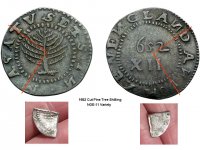BigBobBow
Jr. Member
- Nov 25, 2013
- 52
- 15
- Detector(s) used
- Minelab Explorer SE Pro
- Primary Interest:
- All Treasure Hunting

 Hello folks. I found this cut piece a few years ago and had it placed with some other cut Spanish coins until recently I noticed it was different. I now know it is a 1652 Oak Tree Shilling. My quest is to find out more about it. What variety may it be? Should I get it authenticated? A fellow on another Forum(oxbowbarefoot) gave me some great insight on my piece. He stated it could possibly be a Noe 13.6 or 13.9 or even a 14. Upon this, looking at mine and seeing what those look like, it does seem to appear a match to the 13.6. Any thoughts?
Hello folks. I found this cut piece a few years ago and had it placed with some other cut Spanish coins until recently I noticed it was different. I now know it is a 1652 Oak Tree Shilling. My quest is to find out more about it. What variety may it be? Should I get it authenticated? A fellow on another Forum(oxbowbarefoot) gave me some great insight on my piece. He stated it could possibly be a Noe 13.6 or 13.9 or even a 14. Upon this, looking at mine and seeing what those look like, it does seem to appear a match to the 13.6. Any thoughts?

 Very nice find
Very nice find 



